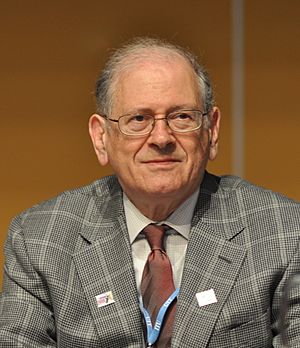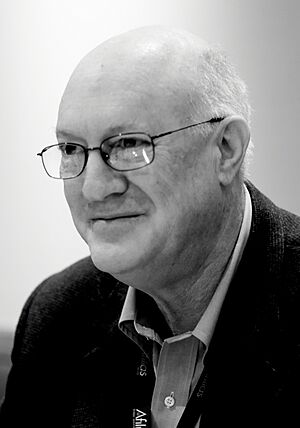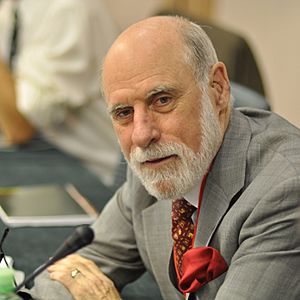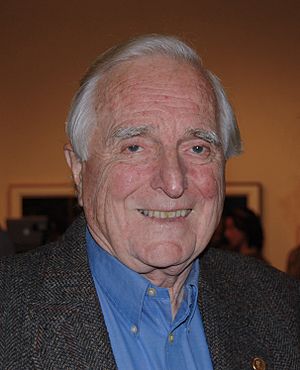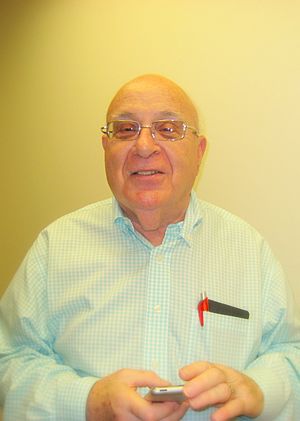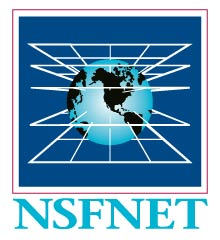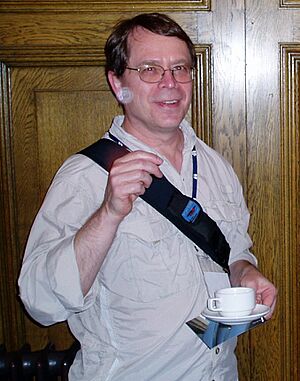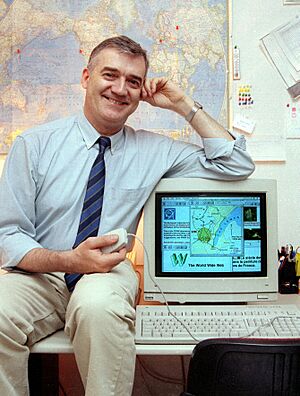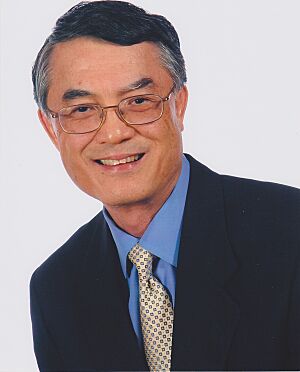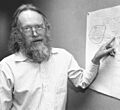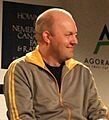List of Internet pioneers facts for kids
The Internet wasn't created by just one person. Many brilliant people worked together over many years to build it. These people are called Internet pioneers because they helped create the basic ideas, rules, and ways to connect computers that led to the Internet we use today.
Some of these pioneers were recognized in important papers, received special awards, or were added to the Internet Hall of Fame. This article will tell you about some of these amazing people and their big contributions.
J. C. R. Licklider: The Visionary
Joseph Carl Robnett Licklider (1915–1990) was a smart researcher who worked at Massachusetts Institute of Technology (MIT). He dreamed of a worldwide computer network where people and computers could work together. He called this "Man-Computer Symbiosis" in 1960, meaning humans and computers would live and work together, making each other stronger.
Licklider led a special office at the United States Department of Defense called IPTO from 1962 to 1963. This office helped fund early computer research, including the ideas that led to the Internet. In 2013, he was honored in the Internet Hall of Fame.
Paul Baran: Packet Switching Pioneer
Paul Baran (1926–2011) was a researcher at RAND Corporation. In the 1960s, he thought about how to build communication networks that could survive attacks. He came up with the idea of a "distributed network." This meant having many paths between any two points, not just one central path.
Baran suggested breaking messages into small "message blocks" (like digital envelopes). These blocks would travel through the network and be put back together at the other end. This idea, called packet switching, was very important for the Internet. He shared his ideas with the ARPANET project, which was an early version of the Internet. Baran received the first IEEE Internet Award in 2000.
Donald Davies: Naming Packet Switching
Donald Davies (1924–2000) was a British scientist who also came up with the idea of packet switching in 1965, independently from Paul Baran. He even gave it the name "packet switching." He worked at the National Physical Laboratory (NPL) in the UK.
Davies proposed building a national data network using this new idea. He was the first to describe an "interface computer" in 1966, which is like today's routers. His team built the NPL network, which was the first working packet-switched network. His work greatly influenced the ARPANET and other networks around the world. Davies also received the first IEEE Internet Award in 2000.
Bob Taylor: Funding the ARPANET
Robert W. Taylor (1932–2017) was a director at ARPA (a U.S. defense research agency) from 1966 to 1969. He convinced ARPA to fund the creation of a computer network. This network became the ARPANET.
In 1968, he wrote a famous paper with J.C.R. Licklider called "The Computer as a Communication Device." This paper imagined a future where people would communicate better through machines than face-to-face. This vision truly predicted what the Internet would become.
Larry Roberts: Leading ARPANET Development
Lawrence G. "Larry" Roberts (1937–2018) was an American computer scientist. After getting his PhD from MIT in 1963, he joined ARPA's IPTO in 1967. He became the leader of the ARPANET project.
Roberts used Donald Davies' ideas about packet switching to build the ARPANET. He also got advice from Paul Baran and other researchers. After Robert Taylor left ARPA, Roberts became the director of IPTO. In 1973, he left ARPA to start a company called Telenet, which was one of the first public data networks. He was inducted into the Internet Hall of Fame in 2012.
Leonard Kleinrock: First ARPANET Connection
Leonard Kleinrock (born 1934) joined the ARPANET project in 1967. He had studied how messages move through networks using queueing theory for his PhD at MIT in 1962.
In 1969, a team at UCLA, led by Kleinrock, connected a computer to an Interface Message Processor (IMP). This became the very first connection point (node) on the ARPANET. His work helped measure and understand how the ARPANET performed. His ideas on hierarchical routing are still important for how the Internet works today. Kleinrock was inducted into the Internet Hall of Fame in 2012.
Frank Heart: Building the IMPs
Frank Heart (1929–2018) worked for Bolt, Beranek and Newman (BBN). From 1966 to 1994, he led the team that designed and built the IMPs. These IMPs were the special computers that handled the routing of information for the ARPANET. They were like the first routers.
Bob Kahn: Co-inventor of TCP/IP
Robert E. "Bob" Kahn (born 1938) is an American engineer and computer scientist. He helped design the IMP subnetwork for the ARPANET.
In 1972, he joined ARPA. He worked on connecting different types of networks, like satellite and radio networks. He realized how important it was for all these different networks to talk to each other. Along with Vint Cerf, he wrote a very important paper in 1974 called A Protocol for Packet Network Intercommunication. This paper laid the foundation for the internetworking protocols that became TCP/IP, the core of the Internet.
Ray Tomlinson: The Birth of Email
Ray Tomlinson (1941–2016) worked for BBN. In 1971, he sent the very first message between two computers on the ARPANET. This was the beginning of modern email! He also started using the "@" symbol to separate a user's name from their computer's name (like `user@computer`).
His work made email popular across the ARPANET, which greatly increased network traffic. Because of this, he is often called "the inventor of modern email." He received the IEEE Internet Award in 2004 for his work on networked email.
Steve Crocker: Creating RFCs
Steve Crocker (born 1944) has been involved with the ARPANET and Internet since the very beginning. As a student at UCLA in the 1960s, he helped create the Network Control Protocol, which was an early set of rules for the ARPANET.
He also started the Request for Comments (RFC) series. RFCs are important documents that describe how the Internet works. He wrote the very first RFC and many more. He also helped create the ARPA Network Working Group, which was the first version of the Internet Engineering Task Force (IETF) that helps guide the Internet today. Crocker received the IEEE Internet Award in 2002 and was inducted into the Internet Hall of Fame in 2012.
Jon Postel: The Internet's Editor
Jon Postel (1943–1998) was a researcher at the University of Southern California's Information Sciences Institute (ISI). He was like the main editor for many of the early RFC documents. He also helped write versions 3 and 4 of TCP/IP.
Postel created the Simple Mail Transfer Protocol (SMTP), which is the main way email is sent over the Internet. He also helped create and manage the Internet Assigned Numbers Authority (IANA), which keeps track of important numbers and names on the Internet. He was inducted into the Internet Hall of Fame in 2012.
Vint Cerf: Co-inventor of TCP/IP
Vinton G. "Vint" Cerf (born 1943) is an American computer scientist. He is known as one of "the fathers of the Internet," sharing this title with Bob Kahn.
At UCLA, he worked on connecting the first two ARPANET nodes. Later, at Stanford University, he worked with Bob Kahn to design the TCP/IP protocol suite. Their important paper in 1974, A Protocol for Packet Network Intercommunication, described how different networks could connect and communicate. Cerf also helped create the Internet Society and Internet Corporation for Assigned Names and Numbers (ICANN), which are important organizations for the Internet. He has received many major awards, including the Turing Award and membership in the Internet Hall of Fame.
Douglas Engelbart: The Mouse and Hypertext
Douglas Engelbart (1925–2013) was an early researcher at the Stanford Research Institute. His lab became the second computer to connect to the ARPANET in October 1969.
Engelbart believed that computers and networks could help solve the world's problems. He is famous for inventing the computer mouse. He also developed hypertext (which lets you click on words to go to other information) and early versions of graphical user interfaces, which are the visual ways we interact with computers today.
Elizabeth Feinler: The Internet's Phone Book
Elizabeth J. "Jake" Feinler (born 1931) worked at SRI. From 1972 to 1989, she was in charge of the Network Information Center (NIC) for the ARPANET. The NIC was like the Internet's phone book, keeping track of names, addresses, and other important information for the network. She was inducted into the Internet Hall of Fame in 2012.
Louis Pouzin: The "Catenet" Idea
Louis Pouzin (born 1931) is a French computer scientist. He built the first wide-area datagram packet-communications network called CYCLADES. This network showed that it was possible to connect many different networks together, which he called a "catenet." His ideas influenced the development of TCP/IP. He received the SIGCOMM Award in 1997 and was inducted into the Internet Hall of Fame in 2012.
Bob Metcalfe: Ethernet Inventor
Bob Metcalfe (born 1946) designed Ethernet, which is a technology that allows computers in a local area (like an office or home) to connect to each other. He also worked on the PARC Universal Packet for connecting networks. He helped with early discussions about the Transmission Control Program (TCP), which is a key part of TCP/IP.
Yogen Dalal: Splitting TCP/IP
Yogen K. Dalal is an Indian electrical engineer and computer scientist. He was an early pioneer of the ARPANET. He helped write the first full specification for the Transmission Control Program (TCP) in 1974 with Vint Cerf and Carl Sunshine.
Later, between 1976 and 1977, Dalal suggested splitting the Transmission Control Program into two separate parts: the Transmission Control Protocol (TCP) and the Internet Protocol (IP). This led to the creation of TCP/IP, which is the fundamental language of the Internet. He also worked on Ethernet and other networking technologies at Xerox PARC.
Peter Kirstein: International Connections
Peter T. Kirstein (1933–2020) was a British computer scientist. In 1973, he set up one of the first two international connections to the ARPANET. His research group at University College London started using TCP/IP in 1982, even before the ARPANET fully adopted it. He played a big role in the very first international Internet experiments. He was inducted into the Internet Hall of Fame in 2012.
Danny Cohen: Real-Time Applications
Danny Cohen (1937–2019) led projects on real-time interactive applications over the ARPANet starting in 1973. He worked at the Information Sciences Institute (ISI) at University of Southern California (USC). He started projects that allowed real-time speech and video over the ARPANET.
In 1981, he made his visual flight simulator work over the ARPANET. This was the first time packet-switching networks were used for real-time applications. He is also known for a paper in 1980 that introduced the terms endianness (big-endian and little-endian) to computing. Cohen was inducted into the Internet Hall of Fame in 2012.
David J. Farber: Building Research Networks
Starting in the 1980s, Dave Farber (born 1934) helped plan and organize major American research networks like CSNET and NSFNET. He also helped create the Gigabit Network Testbed, which proved that IP networking could work at very high speeds. He was inducted into the Internet Hall of Fame in 2013 for his important role in many systems that became today's Internet.
Paul Mockapetris: The Domain Name System
Paul V. Mockapetris (born 1948) worked with Jon Postel at the Information Sciences Institute (ISI) in 1983. He came up with the idea for the Domain Name System (DNS) architecture. DNS is like the Internet's phone book, translating easy-to-remember website names (like `google.com`) into numerical IP addresses that computers understand. He received the IEEE Internet Award in 2003 for his contributions to DNS and was inducted into the Internet Hall of Fame in 2012.
David Clark: Internet Architect
David D. Clark (born 1944) is an American computer scientist. From 1981 to 1989, he was the chief architect for the Internet's protocols as it grew rapidly. He also chaired the Internet Activities Board, which later became the Internet Architecture Board. He is known for his leadership and important contributions to the Internet's design. He has received many awards for his work.
Susan Estrada: Commercializing the Internet
Susan Estrada founded CERFnet in 1988, which was one of the first regional IP networks. Through her leadership, she helped create the connections that allowed the first commercial (business) Internet traffic to flow. She also wrote a book called Connecting to the Internet in 1993. She was inducted into the Internet Hall of Fame in 2014.
Dave Mills: Keeping Time on the Internet
David L. Mills (1938–2024) was an American computer engineer. He invented the Network Time Protocol (NTP) in 1981. NTP is super important because it keeps all the computers on the Internet synchronized to the correct time. This is crucial for many Internet services to work properly. He also developed the fuzzball router used for the early NSFNET and inspired the creation of the ping tool. He received the IEEE Internet Award in 2013 for his work on time synchronization.
Radia Perlman: Mother of the Internet's Trees
Radia Joy Perlman (born 1951) is a software designer and network engineer. She developed the spanning-tree protocol, which is a fundamental rule for how network bridges work. This protocol helps prevent network loops and ensures data can travel efficiently. She also played a big role in developing link-state routing protocols. She received the SIGCOMM Award in 2010 for her important contributions to Internet routing and bridging.
Dennis M. Jennings: Building NSFNET
Dennis M. Jennings is an Irish physicist and Internet pioneer. In 1985, the National Science Foundation (NSF) hired him to lead the creation of the National Science Foundation Network (NSFNET). This network linked powerful supercomputers across the U.S. Jennings made three key decisions for NSFNET: it would be a general research network, it would connect regional networks, and it would use the ARPANET's TCP/IP protocols. These decisions were very important for the Internet's growth. He was inducted into the Internet Hall of Fame in 2014.
Steve Wolff: Transforming the Internet
Stephen "Steve" Wolff worked on the ARPANET and later managed the development of NSFNET at the National Science Foundation (NSF) starting in 1986. He also came up with the Gigabit Testbed, a project that proved IP networking could work at very high speeds. His work at NSF helped turn the early Internet from a small government project into the worldwide network we know today, used by everyone for learning and business. He received the Postel Award in 2002.
Sally Floyd: Controlling Internet Traffic
Sally Floyd (1950–2019) was an American engineer known for her big contributions to Internet architecture. She found practical ways to control and stabilize Internet congestion (when too much data tries to go through at once). She invented the random early detection (RED) method, which is used in almost all commercial routers to manage traffic. Her work helped keep the Internet running smoothly. She received the IEEE Internet Award in 2005.
Van Jacobson: Saving the Internet
Van Jacobson is an American computer scientist. He is famous for his work on how TCP/IP networks perform and scale. His redesign of TCP/IP's flow control rules (called Jacobson's algorithm) helped prevent the Internet from crashing in the late 1980s and early 1990s due to too much traffic. He also helped create useful network tools like traceroute and tcpdump. He was inducted into the Internet Hall of Fame in 2012.
Tim Berners-Lee: Inventing the World Wide Web

Timothy John "Tim" Berners-Lee (born 1955) is a British physicist and computer scientist. In 1989, while working at CERN, he came up with the idea for the World Wide Web. In 1990, with Robert Cailliau, he created the first web browser and web server.
Berners-Lee is the director of the World Wide Web Consortium (W3C), an organization that helps set standards for the Web. He was knighted by Queen Elizabeth II in 2004 for his pioneering work. He was inducted into the Internet Hall of Fame in 2012.
Robert Cailliau: Co-creator of the Web
Robert Cailliau (born 1947) is a Belgian informatics engineer and computer scientist. Working with Tim Berners-Lee at CERN, he helped develop the World Wide Web. He was inducted into the Internet Hall of Fame in 2012.
Simon S. Lam: Secure Sockets
Simon S. Lam (born 1947) is an American computer scientist. He was inducted into the Internet Hall of Fame in 2023 for "inventing secure sockets in 1991." In 1993, he and his students designed and built the first secure sockets layer, called Secure Network Programming (SNP).
This idea of a "secure sockets interface" was new and important. It made it easier for application programmers to add security to their programs. Later secure socket layers, like SSL and TLS, followed his ideas. Today, TLS 1.3 is used for almost all online activities, like banking, shopping, and email, keeping your information safe. Lam and his students won the ACM Software System Award in 2004 for SNP.
Marc Andreessen: The First Popular Web Browser
Marc L. Andreessen (born 1971) is an American software engineer. While working at NCSA, he worked with Eric Bina to create Mosaic. Mosaic was the first widely used web browser and helped make the World Wide Web popular for everyone. He also co-founded Netscape Communications Corporation.
Eric Bina: Co-author of Mosaic
Eric J. Bina (born 1964) is an American computer programmer. In 1993, he worked with Marc Andreessen to create the first version of Mosaic. Mosaic is famous for being the "killer application" that made the Internet popular with millions of people. He also co-founded Netscape Communications Corporation.
Birth of the Internet Plaque
A special plaque celebrating the "Birth of the Internet" was placed at the Gates Computer Science Building at Stanford University on July 28, 2005. It lists many of the key people and groups who helped create the Internet.
BIRTH OF THE INTERNET
THE ARCHITECTURE OF THE INTERNET AND THE DESIGN OF
THE CORE NETWORKING PROTOCOL TCP (WHICH LATER BECAME TCP/IP)
WERE CONCEIVED BY VINTON G. CERF AND ROBERT E. KAHN DURING 1973
WHILE CERF WAS AT STANFORD'S DIGITAL SYSTEMS LABORATORY AND
KAHN WAS AT ARPA (LATER DARPA). IN THE SUMMER OF 1976, CERF LEFT STANFORD
TO MANAGE THE PROGRAM WITH KAHN AT ARPA.
THEIR WORK BECAME KNOWN IN SEPTEMBER 1973 AT A NETWORKING CONFERENCE IN ENGLAND.
CERF AND KAHN'S SEMINAL PAPER WAS PUBLISHED IN MAY 1974.
CERF, YOGEN K. DALAL, AND CARL SUNSHINE
WROTE THE FIRST FULL TCP SPECIFICATION IN DECEMBER 1974.
WITH THE SUPPORT OF DARPA, EARLY IMPLEMENTATIONS OF TCP (AND IP LATER)
WERE TESTED BY BOLT BERANEK AND NEWMAN (BBN),
STANFORD, AND UNIVERSITY COLLEGE LONDON DURING 1975.
BBN BUILT THE FIRST INTERNET GATEWAY, NOW KNOWN AS A ROUTER, TO LINK NETWORKS TOGETHER.
IN SUBSEQUENT YEARS, RESEARCHERS AT MIT AND USC-ISI, AMONG MANY OTHERS,
PLAYED KEY ROLES IN THE DEVELOPMENT OF THE SET OF INTERNET PROTOCOLS.
KEY STANFORD RESEARCH ASSOCIATES AND FOREIGN VISITORS
VINTON CERF
DAG BELSNES JAMES MATHIS
RONALD CRANE JUNIOR BOB METCALFE
YOGEN DALAL DARRYL RUBIN
JUDITH ESTRIN JOHN SHOCH
RICHARD KARP CARL SUNSHINE
GERARD LE LANN KUNINOBU TANNO
DARPA
ROBERT KAHN
COLLABORATING GROUPS
BOLT BERANEK AND NEWMAN
WILLIAM PLUMMER • GINNY STRAZISAR • RAY TOMLINSON
MIT
NOEL CHIAPPA • DAVID CLARK • STEPHEN KENT • DAVID P. REED
NDRE
YNGVAR LUNDH • PAAL SPILLING
UNIVERSITY COLLEGE LONDON
FRANK DEIGNAN • MARTINE GALLAND • PETER HIGGINSON
ANDREW HINCHLEY • PETER KIRSTEIN • ADRIAN STOKES
USC-ISI
ROBERT BRADEN • DANNY COHEN • DANIEL LYNCH • JON POSTEL
ULTIMATELY, THOUSANDS IF NOT TENS TO HUNDREDS OF THOUSANDS
HAVE CONTRIBUTED THEIR EXPERTISE TO THE EVOLUTION OF THE INTERNET.
DEDICATED 28 July 2005
Images for kids
-
Network Time Protocol Public Services Project logo
-
The Web's historic logo designed by Robert Cailliau
See also
- History of the Internet
- History of email
- History of hypertext
- History of the World Wide Web
- Protocol Wars


